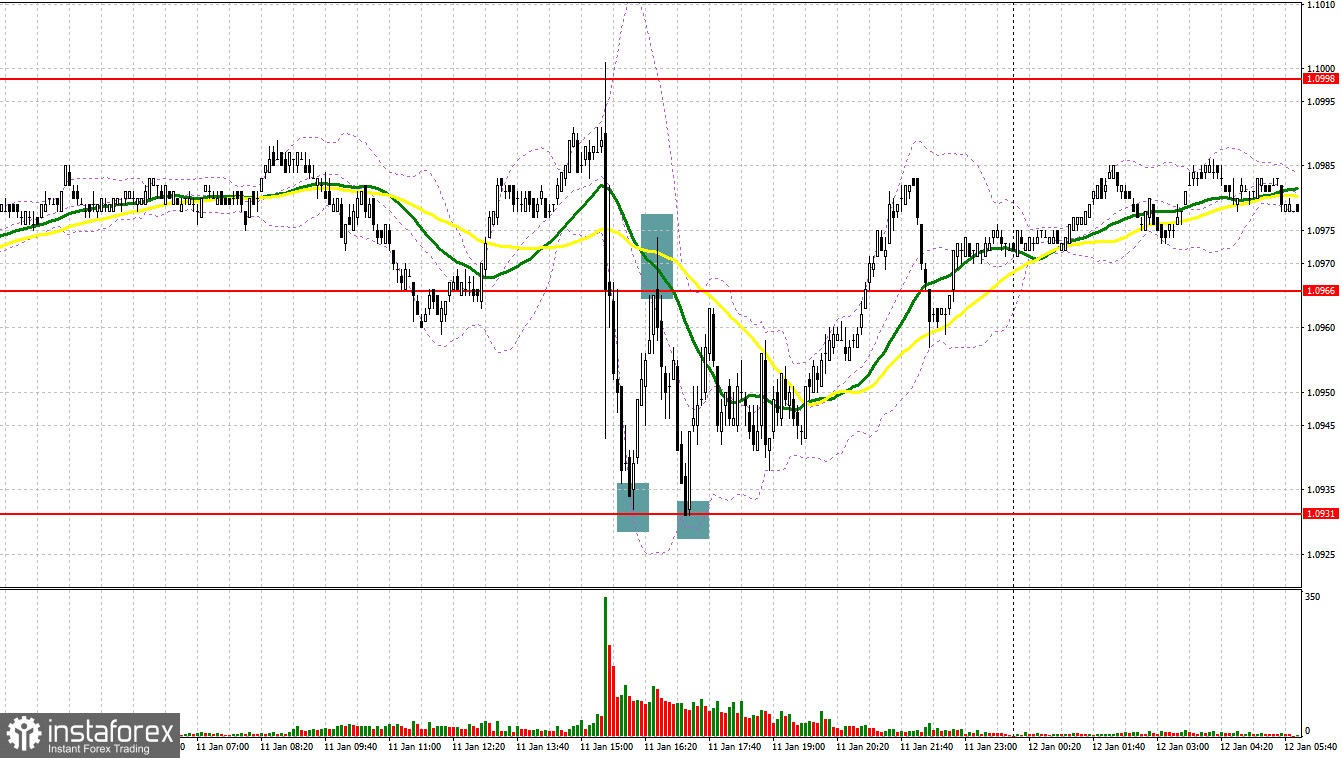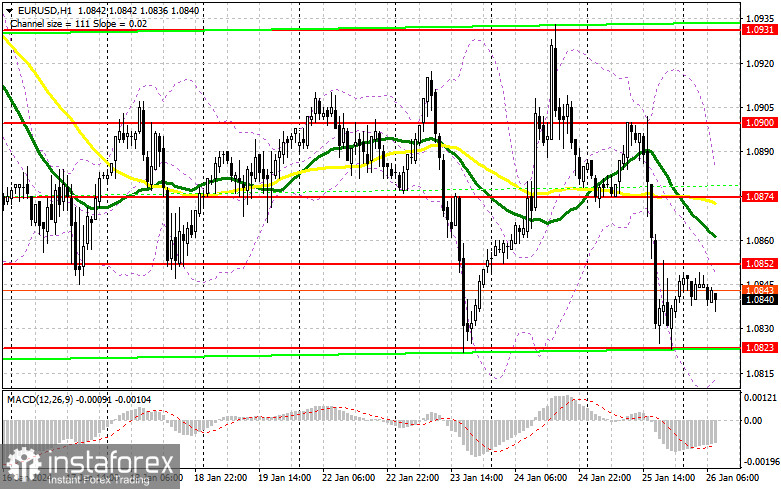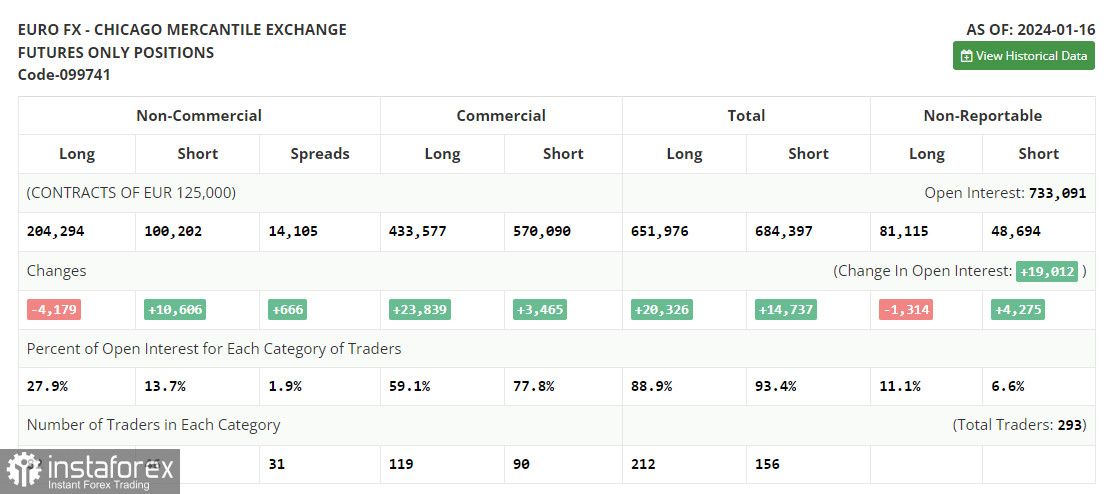Yesterday, the pair formed several entry signals. Let's take a look at the 5-minute chart and discuss what happened. In my previous forecast, I focused on the level of 1.0900 and recommended making market entry decisions based on it. A rise and false breakout of this level generated a sell signal, but the pair did not actively fall. In the afternoon, protecting and forming a false breakout at 1.0931 produced a buy signal, which sent the pair up by 30 pips. Active bearish pressure around 1.0966 created an entry point towards developing a trend, which pushed the price back to around 1.0931.

For long positions on EUR/USD
Strong US GDP data and the European Central Bank representatives' dovish tone were enough to exert pressure on the euro. As a result, the pair fell to the monthly low, from which it has yet to recover. Today, in the first half of the day, we only have data on Germany's leading consumer sentiment index, changes in the eurozone's M3 money supply, and private sector lending. These reports may not help the euro recover, so buyers will have to carefully consider how to defend the nearest support at 1.0823. Forming a false breakout there, along with strong German data, would be a suitable option for me to enter the market with the goal of correcting higher towards 1.0852. Only a breakout and a downward test of this range will create a good entry point for long positions, aiming for an upward correction and potentially testing 1.0874, which is in line with the bearish moving averages. The ultimate target is found at the 1.0900 high where I plan to take profits. Should EUR/USD decline and show no activity at 1.0823 in the first half of the day, which is likely to be the case, the pressure on the pair will return. In this case, I will try to enter the market after a false breakout forms around 1.0782. I would consider opening long positions on a rebound from 1.0744, aiming for an upward correction of 30-35 pips within the day.
For short positions on EUR/USD:
Bears retain the chances to build a new trend. To do this, they will need to defend 1.0852 and push the pair to 1.0823, a level that has already been tested twice in the last week. In case the pair edges up in the first half of the day, forming a false breakout at 1.0852 would confirm the presence of major players in the market, which may push the pair down to the area of 1.0823. Only after a breakout and consolidation below this range, as well as an upward retest, do I expect another sell signal at 1.0782. The ultimate target here is the 1.0744 low, where I plan to take profits. In case EUR/USD moves upwards during the European session without bearish activity at 1.0852 with very good German and eurozone data, the demand for EUR/USD will return, and it may be possible to cover the pair's losses from yesterday, which will keep the pair trading within the sideways channel. In that case, I will delay going short until the price tests the next resistance at 1.0874. I may consider selling there but only after a failed consolidation. I plan to initiate short positions on a rebound from the 1.0900, aiming for a downward correction of 30-35 pips.

COT report:
In the COT report (Commitment of Traders) for January 16, there was a decrease in long positions and an increase in short positions, which indicates a change in the balance of power in favor of the U.S. dollar. Obviously, a strong labor market and a high probability of a new spike in U.S. inflation early this year helps maintain the chances of a tight policy from the Federal Reserve. If the timing of the first Fed rate cut is pushed to a later period, this will help the dollar strengthen against the euro. The European Central Bank meeting will be held this week, and the Bank may also leave rates unchanged in its fight against inflation, which should level the euro's position in the EUR/USD pair, and help keep the price within the channel. The COT report indicated that long non-commercial positions fell by 4,179 to 204,294, while short non-commercial positions increased by 10,606 to 100,202. As a result, the spread between long and short positions increased by 666.

Indicator signals:
Moving averages:
Trading below the 30- and 50-day moving averages indicates a possible decline in the pair.
Please note that the time period and levels of the moving averages are analyzed only for the 1H chart, which differs from the general definition of the classic daily moving averages on the 1D chart.
Bollinger Bands
If EUR/USD declines, the indicator's lower border near 1.0810 will serve as support.
Description of indicators:
• A moving average of a 50-day period determines the current trend by smoothing volatility and noise; marked in yellow on the chart;
• A moving average of a 30-day period determines the current trend by smoothing volatility and noise; marked in green on the chart;
• MACD Indicator (Moving Average Convergence/Divergence) Fast EMA with a 12-day period; Slow EMA with a 26-day period. SMA with a 9-day period;
• Bollinger Bands: 20-day period;
• Non-commercial traders are speculators such as individual traders, hedge funds, and large institutions who use the futures market for speculative purposes and meet certain requirements;
• Long non-commercial positions represent the total number of long positions opened by non-commercial traders;
• Short non-commercial positions represent the total number of short positions opened by non-commercial traders;
• The non-commercial net position is the difference between short and long positions of non-commercial traders.
 English
English 
 Русский
Русский Bahasa Indonesia
Bahasa Indonesia Bahasa Malay
Bahasa Malay ไทย
ไทย Español
Español Deutsch
Deutsch Български
Български Français
Français Tiếng Việt
Tiếng Việt 中文
中文 বাংলা
বাংলা हिन्दी
हिन्दी Čeština
Čeština Українська
Українська Română
Română

